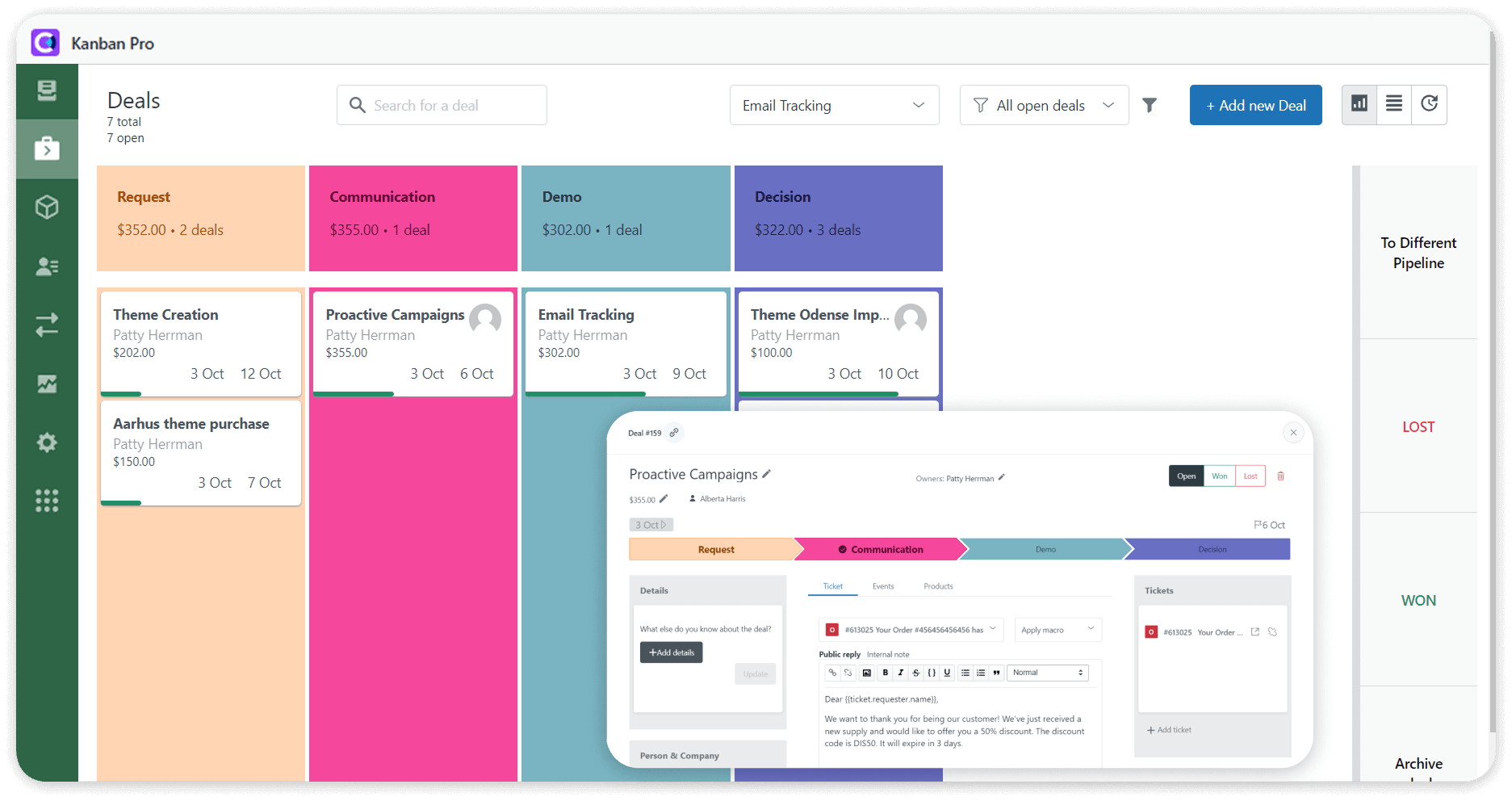Regardless of your organization type, the marketing vs. sales dilemma has bothered you. Planning and strategy development of both areas is an important part of the success as these departments share a mutual goal - revenue increase. In some ways, marketing and sales are intertwined, and startups and small companies have only one person, the so-called marketing.
However, marketing and sales aren’t interchangeable, and as businesses grow, they often split their marketing teams into separate departments. As a rule, b2b organizations are sales-driven, while b2c is marketing-driven. The difference between sales and marketing in terms of roles and responsibilities is outlined below.

translate to french, german, spanish, brazilian portuguese. Leave html code:
Definition of marketing and sales
What is marketing?
Before determining what is more vital - marketing or sales -let’s get the overall definition of both areas.
As a more dynamic process, marketing deals with systematic planning, implementation of marketing strategy, control, and improvement of business actions and products or services. It targets to create brand identity, brings leads and prospects for a sales department, involves sending email campaigns to customers, and builds long-term relationships with potential customers. However, the marketing department has given conditions, and can’t change them.
What is sales?
Meanwhile, sales strategy focuses on a transaction between two parties and an agreement on the price and security with the help of negotiations and overcoming objectives. This activity is driven by human interaction and has rather a short-term relationship with buyers. That means that sales reps can transform the situation using their personal skills.
Sales and marketing responsibilities
Marketing responsibilities
If you’re considering a move from sales to marketing, it’s important to understand how responsibilities differ.
Marketing is primarily focused on creating demand, building awareness, and shaping how a product or service is perceived in the market. It works on the 4Ps: product, price, place, and promotion. Marketers often conduct micro and macro market analysis to understand consumer behavior, competition, and industry trends. They then use this research to design strategies that attract, engage, and retain customers.
Key marketing efforts include:
- Advertising campaigns (online and offline promotions)
- Public relations (building company image and trust)
- Social media management (community building and engagement)
- Relationship marketing (nurturing long-term customer loyalty)
- Brand marketing (strengthening brand identity and recognition)
- Viral marketing (creating shareable content that spreads fast)
- Content marketing (blogs, videos, guides, infographics, etc.)
- Email campaigns (nurturing leads and customer communication)
- Market research & analytics (evaluating customer insights and campaign performance)
- Product positioning (deciding how the product should be perceived by the target audience)
In short, marketing creates the opportunities that sales later convert.
Sales responsibilities
Sales responsibilities are more direct and focused on converting leads into paying customers. The sales process is customer-facing, personal, and relationship-driven. Unlike marketing, which works on the 4Ps, sales often operates under the 4Cs: customer solution, customer cost, convenience, and communication.
Sales professionals work closely with prospects, understanding their needs, offering solutions, and ultimately closing deals. Their success is measured by quotas, revenue generated, and relationship quality with clients.
Key sales efforts include:
- Follow-up calls (checking in with leads and customers)
- Sales letters & proposals (personalized offers and presentations)
- Meetings & demos (explaining product benefits face-to-face or virtually)
- Cold calls & outreach (generating new business opportunities)
- Networking & events (building personal connections and partnerships)
- Negotiations & deal closing (turning interest into signed contracts)
- Account management (maintaining and growing customer relationships)
- Upselling & cross-selling (increasing customer value through additional offers)
In essence, sales takes the demand that marketing creates and turns it into measurable revenue.
Sales vs Marketing share a common goal: the development of customer relationships, yet from different perspectives. Both of these business processes require specific skills, training from the staff, and communication and cooperation within the company. To put it simply, sales can’t succeed in the revenue objectives without developing future-focused marketing methods and marketing strategies.

Difference between sales and marketing
So, are marketing and sales the same things? Often both teams' duties and responsibilities overlap. However, there are some key differences in these business functions.
Market changes are permanent things, so marketing has to stay ahead of the changes. The marketing process includes:
- Helping sales by locating the potential audience and/or channel partners.
- Developing pricing strategies.
- Generating quality leads.
- Enhancing information transactions.
From this point, the sales continue to build customer service and convert leads or prospective customers into actual paying buyers by direct interaction. They set specific boundaries for closing the deals: week, month, or quarter.
Dealing with the marketing vs sales dilemma, you should remember that these activities demand different skills and training. Definitely, marketing provides tactics and clues for the sales team. However, this department shouldn't perform an auxiliary function.
The following comparison will aid you in the roles and responsibilities distribution among your teams.
If you still ask Google: ‘How is marketing different from sales?’, here are the comparisons regarding these positions.

Strategy
By employing strategic thinking, marketing uses the pull strategy and generates interest in the products or services. Nevertheless, the role of sales teams within a marketing strategy is focused on tactical thinking by pushing this strategy to convince a customer and ensure a closed deal.
Priority
In this aspect, marketing vs sales works in cooperation. Meanwhile, marketing shows the ways to reach a customer and sets up relationship building; sales applies the received info and tips for achieving the ultimate result - a paying buyer and customer satisfaction.
Goals
We already know that marketing & sales, in some cases, are substitutional. Moreover, if to generalize the goal of both departments so it will make a profit for the company. The difference is in subgoals and used methods to achieve them. For a sale rep, the primary goals are to drive the company's revenue and increase the average purchase value. To monitor this, managers determine individual sales rep quotas and commissions.
On the contrary, the goal of marketing is to provide the sales team with prospects and leads. Marketers lure future customers and care about their awareness, conversion, engagement and retention.
As you can see, sales and marketing roles have different aims while talking about sales. So, they should work side by side.
Processes
The responsibilities of the sales and marketing departments differ in their approach to achieving their goals. Marketers use funnels to communicate with the target audience as well as generate and deliver potential leads to the sales team. Each funnel stage requires a specific approach to introduce products or services, highlighting the pains they can alleviate. After a sales rep carries a prospect and gets a customer, a marketer still gives support to gain client loyalty and increase retention.
The sales process differs quite significantly from marketing. The easiest way to explain this is to learn the sales pipelines. All the stages included in the pipelines are part of the sales team's processes. They receive the inquiry, create a deal, communicate potential leads, build reliable relationships, transform prospects into clients, win or lose the deal, and support customers if they have any questions during or after the purchase. This way, sales also provide customer retention. Therefore, the 'sales vs marketing' formulation is sometimes inappropriate, as these departments should always work together.
Tools and Resources
Now we have a lot of efficient technologies and tools, and the variants to utilize them also highlight the difference between marketing and sales.
The well-known tool among sales reps is CRM (Customer Relationship Management). This technology allows sales teams to manage sales pipelines and deals, chat, make meeting appointments, create invoices, view the statistics and check KPIs. They can also use other tools and software to achieve the same results, but it takes more time and decreases the productivity of sales representatives.
For Zendesk users, there is a good way to implement the CRM system without buying Zendesk Sell, and this is an application called Kanban Pro. The integration can be installed on Zendesk Support, providing all the necessary CRM features and customization opportunities. Try a free trial to get an overview of the app's capabilities.

So, what about the marketer and their tools? Quite often, digital marketing representatives use the tools that are appropriate for internet marketing. For example, SEO or SMM activity are aimed at website and social media promotion. Besides, marketing requires knowledge of project management and content creation tools. Also, creating marketing campaigns via emails is the primary skill almost every marketer should do. The ability to use all the instruments properly shows how important the role of marketing and sales is.
Perspective
Due to marketing search, the company gets the market view from the customer's perspective. This way, the organization is directed to the targeted audience or group.
Sales work in the opposite direction. They present the positioning of the product or service from inside the organization toward the potential buyers.
Approach
Apart from extending the variety of selling activities, marketing develops a strategy for determining current and future customers’ needs. This is essential to lay out the basis for long-term relationships.
Despite customer relationship management, sales try to fulfill buyers’ demands. For this, they match the company’s product or service within a specified period.
Major Focus
Marketing deals with the promotion and distribution of a product or service's price and seeks ways to fulfill customers' needs through the company's offerings.
The key targets for the sales teams are to achieve a set quota and fulfill sales volume objectives outlined in sales plans.
How Sales and Marketing Work Together
Although sales and marketing have different roles, their success is deeply connected. Marketing generates awareness, interest, and qualified leads, while sales builds relationships and converts those leads into paying customers. When both teams align, businesses achieve faster growth, stronger customer relationships, and higher revenue.
Collaboration between sales and marketing often includes:
- Sharing insights: Marketing provides sales with data on customer behavior, while sales shares feedback from honest conversations with prospects.
- Lead qualification: Marketing helps identify and score leads, ensuring sales teams focus on the most promising opportunities.
- Content alignment: Marketing creates tailored materials, case studies, brochures, and presentations that sales can use to close deals.
- Consistent messaging: Both teams collaborate to ensure customers receive a unified message across all channels.
- Feedback loop: Sales feedback enables marketing to adjust campaigns, refine targeting, and enhance communication strategies.
When sales and marketing work in harmony, they create a seamless customer journey—from first touch to long-term loyalty.
Integrating sales and marketing
Despite the differences between marketing and sales, they work together, and only in synergy do they achieve sales goals and generate revenue for the business owner. Sometimes, friction and misunderstandings can arise between marketing and sales managers as they work towards the same goal. Also, if someone slows down, the other pulls them up. Need to know how to avoid it? Here are some valuable tips:
1. Set Shared Goals
Start by getting everyone on the same page.
- Agree on common goals, such as increasing revenue, improving lead quality, or shortening the sales cycle.
- Create a simple service agreement: marketing delivers a certain number of qualified leads, and sales follows up promptly.
When both teams are chasing the same outcomes, collaboration becomes a no-brainer.
2. Create a Seamless Customer Journey
Customers shouldn’t feel like they’re being tossed from one team to the other.
- Work together to map out the customer’s journey, from the first ad they see to the moment they sign on the dotted line.
- Keep your messaging consistent so customers don’t get mixed signals.
A smooth journey makes customers happy—and happy customers lead to more sales.
3. Use the Right Tools
Technology can be your best friend in aligning marketing and sales.
- A shared CRM, like HubSpot, Salesforce or Kanban Pro for Zendesk, keeps everyone on the same page.
- Tools like Mailchimp or Marketo help automate campaigns, so leads don’t fall through the cracks.
When both teams have access to the same data, it’s easier to stay aligned.
4. Make Communication Easy
Break down silos by keeping the conversation flowing.
- Schedule regular check-ins to review progress, share insights, and tweak strategies.
- Set up shared dashboards to track key metrics like lead conversion rates and pipeline performance.
The more you talk, the better you’ll work together.
One way to enhance this communication loop is by equipping both teams with tools that simplify engagement and follow-ups. For instance, custom digital business cards from Wave Connect allow sales and marketing professionals to instantly share updated contact information, links, and even campaign assets with prospects and internal stakeholders. These cards reduce friction in the handoff process and offer analytics that help teams see which interactions lead to conversions. As a result, collaboration becomes more data-driven and aligned with measurable outcomes.
5. Focus on Quality, Not Quantity
More leads don’t always mean more sales—it’s about targeting the right ones.
- Create a clear lead scoring system to define what a “qualified lead” looks like.
- Nail the handoff process between marketing and sales to avoid any confusion.
A strong focus on quality ensures both teams are working smarter, not harder.
6. Build Bridges with Training
Want your teams to understand each other better? Get them talking!
- Cross-train marketing and sales teams so that each knows what the other does.
- Let them shadow each other to see how their efforts connect.
When people understand each other’s challenges, collaboration naturally improves.
7. Celebrate Together
Nothing builds teamwork like shared wins.
- Celebrate significant achievements, such as surpassing revenue goals or launching a successful campaign.
- Align incentives so both teams feel motivated to hit joint targets.
Recognizing success together keeps everyone inspired and engaged.
8. Keep Feedback Flowing
Great teams listen to each other.
- Sales can share what customers are saying and how leads are performing.
- Marketing can share campaign results and trends to help sales refine their approach.
Use feedback to improve and adapt your strategies constantly.

Final Thoughts
After revealing the crucial moments, you see that marketing vs sales differences lie in various approaches, tactics, strategies, and personnel-specific skills. However, in small businesses, even both teams only sometimes know the difference between marketing and sales. Both teams work on developing a trustful relationship with customers and boosting revenue. In short, you can achieve high results by setting up workflows for both teams, with communication as a must.
FAQs
1. What is the difference between sales and marketing?
Marketing focuses on generating interest and leads, creating the brand identity, and communicating value to the target audience. Sales, on the other hand, is the process of closing the deal, converting a lead into a paying customer, and managing customer relationships to drive revenue. While distinct, they are interdependent processes.
2. How do sales and marketing work together in a business?
Ideally, sales and marketing should be tightly aligned, a concept known as "Smarketing." Marketing provides the sales team with qualified leads and relevant content (like brochures or case studies), while sales provides feedback to marketing on the quality of leads and the effectiveness of materials. This collaboration ensures a seamless customer journey from initial awareness to final purchase.
3. What are the main responsibilities of a sales team?
The core responsibilities of a sales team include: prospecting for new leads, qualifying leads to determine their potential, presenting the product or service, negotiating contracts, closing sales, and managing existing customer accounts to ensure satisfaction and encourage repeat business or upsells. They are directly responsible for achieving the company's revenue targets.
4. What are "qualified leads" and who is responsible for them?
A qualified lead is a potential customer who has been vetted and meets certain criteria, making them highly likely to purchase. In most businesses, **marketing** is responsible for generating and nurturing leads until they meet the criteria (Marketing Qualified Lead or MQL). Once qualified, the lead is passed to the **sales** team, where they become a Sales Qualified Lead (SQL), and sales takes over the process of closing the deal.
5. What key metrics do sales and marketing share?
While both teams track their own metrics, the most important shared metric is Customer Acquisition Cost (CAC). Other key shared metrics include the Lead-to-Customer Conversion Rate (the percentage of leads that become paying customers) and the Sales Cycle Length (the time it takes a lead to progress from initial contact to a closed sale). Tracking these together helps identify bottlenecks in the overall process.
6. What is a Service-Level Agreement (SLA) between sales and marketing?
A Service-Level Agreement (SLA) is a formal, written agreement that defines the expectations between the sales and marketing teams. The marketing SLA outlines the quantity and quality of leads marketing will deliver to sales, while the sales SLA defines how quickly and consistently the sales team will follow up on those leads. This formal document is crucial for accountability and alignment.








